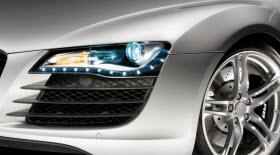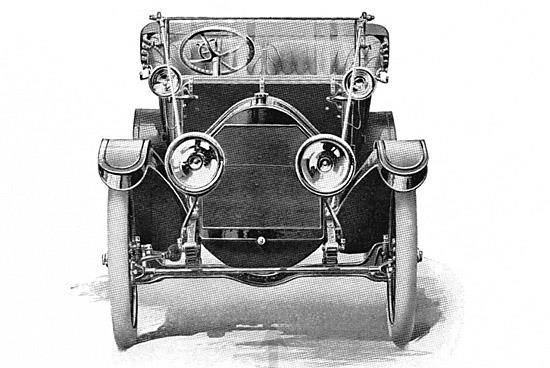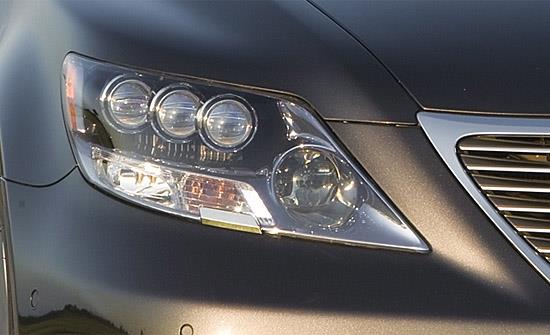 From cloud-connected in-dash applications to autonomous cars, we’re in the midst of an automotive technology renaissance that’s changing the way we drive. Headlight technology is also evolving rapidly and, excuse the pun, pointing the way to a safer future.
From cloud-connected in-dash applications to autonomous cars, we’re in the midst of an automotive technology renaissance that’s changing the way we drive. Headlight technology is also evolving rapidly and, excuse the pun, pointing the way to a safer future.
Until the advent of high-intensity discharge (HID) headlights 20 years ago, no significant changes in automotive front lighting had occurred since the 1960s. But the growing use of LEDs for a car’s front lighting is driving innovation to make cars safer. It also makes them look cooler.
While night driving represents a quarter of the nation's traffic, about half of all fatal car accidents occur after dark, according to the National Highway Traffic Safety Administration. With the recent rapid advances in automotive lighting, that statistic could be reduced.
But first, NHTSA has to allow the technology.
Cadillac introduced the first electric headlight system in 1912, and the U.S. luxury brand also developed the first interior-mounted lever to switch between high-beam and low-beam headlights. The first modern headlight to incorporate both high and low beams was introduced in 1924, followed by the foot-operated dimmer switch three years later.
 The 1912 Cadillac Model 30, as seen in an advertisement.
The 1912 Cadillac Model 30, as seen in an advertisement.
Except for styling and shapes, headlight technology didn’t change a lot for almost four decades, when the first halogen headlight was introduced in Europe in 1962. Halogen headlights quickly became mandatory in many countries, although most cars in the U.S. used non-halogen headlights until 1978.
Because they produced more light than previous headlights using almost an equivalent amount of power, halogen headlights became popular around the world, and most automakers still use them on their latest models.
The next technology breakthrough was HID systems, also called xenon headlights. They not only provide brighter light than halogen headlights but have a longer estimated life – 2,000 hours on average, compared with 1,000 hours for halogens – and they're more energy efficient. The first car to use xenon headlights was the 1991 BMW 7-Series.

The latest leap in headlight technology comes courtesy of LEDs. Like early HID headlamps, LED automotive lighting initially appeared on luxury cars due to its added expense. And while LED automotive lighting is more costly, lower power requirements have made it important for use in hybrid and electric vehicles.
 A trio of LED low-beam headlights as seen on the Lexus LS 600hL.
A trio of LED low-beam headlights as seen on the Lexus LS 600hL.
The first factory-installed LED headlights were on the 2008 Lexus LS 600h hybrid for low-beam and side-marker lighting, with the high-beam and turn-signal lighting using traditional filament bulbs. Although LED lighting is still not practical for primary headlight duties, many automakers have adopted LED technology for use with turn signals, daytime running lights or brake lights.
LEDs also allow for more flexible applications than other types of lighting so that automakers can be more creative with shapes and assemblies. LED daytime running lights became a styling signature of Audi vehicles, for example, and were quickly copied by other brands.
Audi has also been working on adapting LED lighting for better and safer uses. At the recent 2013 Consumer Electronics Show, Audi unveiled its Matrix LED lighting, in which LEDs are divided into several different segments. This allows the LEDs to be independently activated, deactivated or dimmed and to work in conjunction with lenses or reflectors to adjust light according to environmental situations – without any action on the part of the driver.
 An artistic representation of Audi's Matrix LED headlights.
An artistic representation of Audi's Matrix LED headlights.
The Matrix LED lighting can also receive input from an onboard camera so that when it detects other vehicles ahead or behind, sections of the high beam can be blocked. The system can even receive input from the car's navigation system to know what's ahead and automatically swivel, for example, when the car approaches a curve.
Audi initially said that Matrix LED would be available in the U.S. sometime in 2013, but the system doesn’t fit the Federal Motor Vehicle Safety Standard 108, which states that “headlights are not allowed to shine in such a dynamic way.” According to Automotive News, Audi has asked NHTSA for an interpretation of the standard to determine how the Matrix headlights can be allowed in the U.S.
Ironically, the only thing holding back safety advances such as Audi’s Matrix LED lighting is the federal agency in charge of ensuring automotive safety.
Doug Newcomb has been covering car technology for more than 20 years for outlets ranging from Rolling Stone to Edmunds.com. In 2008, he published his first book, "Car Audio for Dummies" (Wiley). He lives and drives in Hood River, Ore., with his wife and two kids, who share his passion for cars and car technology, especially driving and listening to music.
Source: MSN
No comments:
Post a Comment